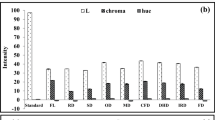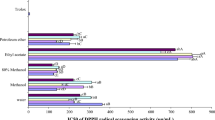Abstract
Mimosa, an excellent energy crop candidate because of its high growth yield, also contains, on a dry basis, 0.83% hyperoside and 0.90% quercitrin. Hyperoside has been documented as having anti-inflammatory and diurectic properties, whereas quercitrin may play a role in intestinal repair following chronic mucosal injury. Thus, mimosa might first be extracted for important antioxidant compounds and then used as a feedstock for energy production. This article presents results from studies aimed at determining the effect of three extraction parameters (temperature, solvent composition, and time) on the yield of these important quercetin compounds. Conditions are sought which maximize yield and concentration, whereas complementing subsequent biomass pretreatment, hydrolysis and fermentation.
Similar content being viewed by others
References
Renewable Fuels Association (2005), Homegrown for the homeland, ethanol industry outlook 2005. www.ethanolrfn.org/outlook2005.html.
Bransby, D. (2001), Development of optimal establishment and cultural practices for switchgrass as an energy crop. Annual Report for US Dept. of Energy contract No. 19X-SY164C, Oak Ridge National Laboratory, Oak Ridge, TN.
Lynd, L., Wyman, C., and Gerngross, T. (1999), Biotechnol. Prog. 15(5), 777–793.
Lau, C., Carrier, D. J., Howard, L., Lay, J., Liyanage, R., and Clausen, E. C. (2006), Bioresour. Technol., in press.
Carr, T., Pedersen, H., and Ramaswamy, S. (1993), Environment 35, 14–38.
Mendelsohn, R. and Balick, M. J. (1995), Econ. Bot. 49, 223–228.
Freedonia Group (1998), Cleveland, OH, http://freedoniagroup.imrmall.com.
Giusti, M. and Wrolstad, R. (2001) Characterization and measurement of anthocyanins by UV-visible spectroscopy. In Current Protocols in Food Analytical Chemistry, Wrolstda R (ed), John Wiley & Sons. New York.
Lau, C. S., Carrier, D. J., Howard, L. R., Lay, J. O. Jr., Archambault, J. A., and Clausen, E. C. (2004), Appl. Biochem. Biotechnol. 114, 569–583.
Duan, L., Lovelady, J. K., Carrier, D. J., and Clausen, E. C. (2005), J. Agri. Food Chem., in press.
Schell, D. J., Farmer, J., Newman, M., and McMillan, J. D. (2003), Appl. Biochem. Biotechnol. 105–108, 69–85.
Author information
Authors and Affiliations
Corresponding author
Rights and permissions
About this article
Cite this article
Ekenseair, A.K., Duan, L., Carrier, D.J. et al. Extraction of hyperoside and quercitrin from mimosa (Albizia julibrissin) foliage. Appl Biochem Biotechnol 130, 382–391 (2006). https://doi.org/10.1385/ABAB:130:1:382
Issue Date:
DOI: https://doi.org/10.1385/ABAB:130:1:382




